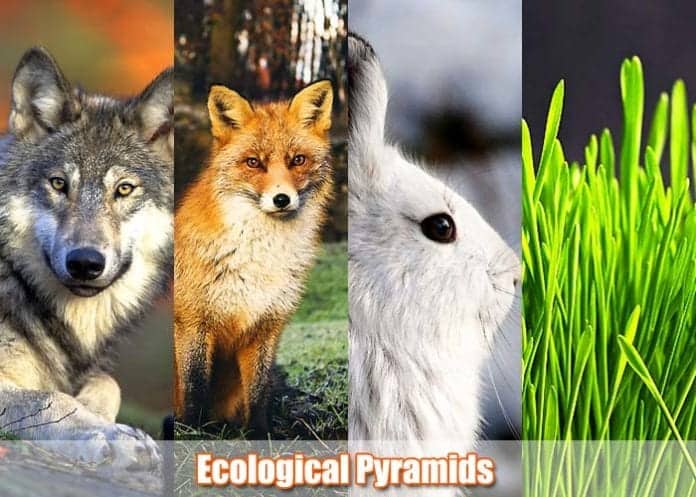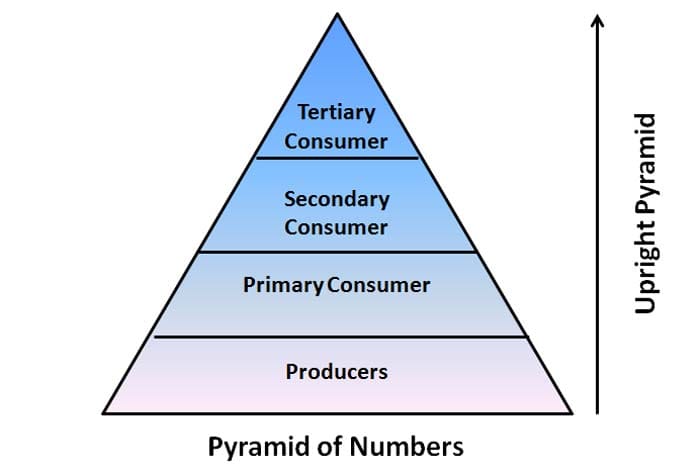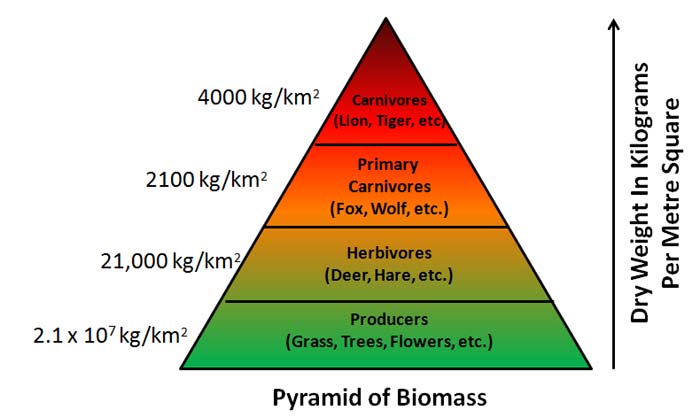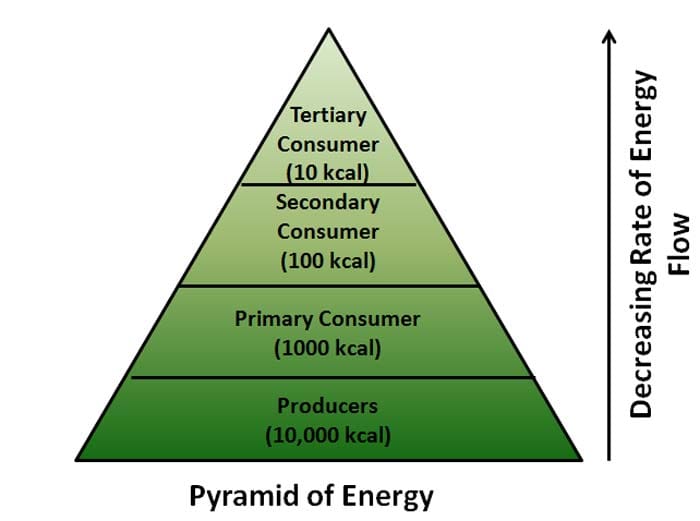what happens to biomass as you move up

Ecological Pyramids: An ecosystem is defined equally a community composed of both living and nonliving entities that altogether live and work together.
Ecosystems take no definite sizes as they tin be as minor equally a tree or every bit large as the whole land mass. Ecosystems are broken into unlike ranks called trophic levels.
Every organism then is classified based on unlike environmental factors like how they live in a certain ecosystem (what they eat and how they obtain energy). Organisms that make their own food using the sunlight are called producers.
Tabular array of Contents
- What is an Ecological Pyramid?
- Why are ecological pyramids shaped as pyramids?
- Three Major Types of Ecological Pyramid
- ane. Pyramid of Number
- 2. Pyramid of Biomass
- 3. Pyramid of Energy
- Limitations of Ecological Pyramids
- References
The next level in the hierarchy is the consumers that consume the producers and they are categorized as primary, secondary, or tertiary. Primary consumers are the ones that feed on the producers, secondary consumers are the organisms that consume the main consumers, and the tertiary consumers are the ones that consume both main and secondary consumers.
Ecologists accept devised certain ways to classify organisms into trophic levels and one of which is the use of ecological pyramids. Permit'due south take a closer look.
![]()
What is an Ecological Pyramid?

In 1927, the concept of ecological pyramid was outset proposed by English Ecologist named Charles Elton (1900-1991) (thus, they are also known equally Eltonian pyramids). An ecological pyramid is basically a pyramidal depiction of the number of organisms, biomass , and productivity in each trophic level in an ecosystem.
- Typically, ecological pyramids get-go with producers located at the lesser and transcend through diverse trophic levels every bit y'all go up the pyramid. The top of the pyramid represents the highest level in the food concatenation.
![]()
Why are ecological pyramids shaped as pyramids?
When the food passed from primary producers to secondary consumers and then to tertiary consumers (carnivores), it is estimated that about 10% of free energy is lost during the procedure. To graphically explicate this concept, ecologists came up with the pyramid diagrams, hence the 'Ecological Pyramids.'
![]()
Three Major Types of Ecological Pyramid
3 major types of ecological pyramids be: pyramid of number, biomass, and energy. They are described as follows.
ane. Pyramid of Number
The get-go pyramid is the pyramid of numbers which graphically represents the population (total number of individuals) nowadays at each trophic level.
- This type of pyramid can have two different forms depending on the number of organisms: upright and inverted.
- In an upright pyramid of number, the number of organisms generally decreases from the lesser to tiptop. This by and large occurs in grassland and pond ecosystems where the plants (usually the grasses) occupy the base of the pyramid. The succeeding levels of the pyramid include the consumers.
- An inverted pyramid of number, on the other paw, is simply the opposite of the erstwhile. It is unremarkably observed in tree ecosystems with the trees every bit the producers and the insects as consumers.
 Amid the three types of ecological pyramids, the pyramid of number is the least accurate for it does not take account the verbal number of population and therefore cannot completely define the trophic structure in that ecosystem.
Amid the three types of ecological pyramids, the pyramid of number is the least accurate for it does not take account the verbal number of population and therefore cannot completely define the trophic structure in that ecosystem.
![]()
2. Pyramid of Biomass
Biomass is defined every bit the amount of biomass per unit area product of the living cloth present in an organism and the total number of organisms present) in a specific trophic level. In less complicated terms, it refers to the food bachelor for the succeeding trophic level.
- For case, a pyramid of biomass is a depiction of the amount of nutrient available and how much energy is being passed on at each trophic level. Most the biomass that animals swallow is used to provide the energy, converted to new tissues, or just remain undigested.
- Almost of the time, pyramids of biomass are in a true pyramidal shape with biomass in the lower trophic levels are greater than the trophic levels above them.
- Like the pyramid of numbers, the pyramid of biomass can either have two forms: upright and inverted. Usually, terrestrial ecosystems are characterized past an upright pyramid of biomass having a larger base of operations (primary producers) with the smaller trophic levels (consumers) located at the meridian.
- On the other hand, aquatic ecosystems are the complete contrary equally they will assume the inverted structure of the pyramid. This is because the phytoplankton producers (with generally smaller biomass) are located at the base while the consumers having larger biomass are located at the top of the pyramid.
 Biomass is besides used as a source of renewable energy in replacement of fossil fuels. This alternative has dramatically helped in the comeback of the planet's climatic conditions. A wide variety of benefits can be obtained from the utilization of biomass as a fuel, and they include the reduction of wastes and low costs.
Biomass is besides used as a source of renewable energy in replacement of fossil fuels. This alternative has dramatically helped in the comeback of the planet's climatic conditions. A wide variety of benefits can be obtained from the utilization of biomass as a fuel, and they include the reduction of wastes and low costs.
![]()
3. Pyramid of Energy
Last but not the least, is the pyramid of free energy that shows the overall energy in the ecosystem and how much energy is required by organisms as it flows upward the higher trophic levels.
- The design of the free energy flow in this type of pyramid is based on the principles of thermodynamics. This law specifically says that energy is neither exist created nor destroyed; but transformed into another course.
- This pyramid shows that energy is transferred from lower trophic levels with more amount of energy (producers) to higher ones (consumers) and converted in the biomass.
- Therefore, it can exist concluded that organisms found at the highest trophic levels of shorter food bondage bear a greater amount of energy than the ones constitute in longer ones.
- Unlike the beginning two ecological pyramids, the pyramid of energy is always illustrated in an upright position, with the largest free energy carriers at the base of operations.
 The thought of the pyramid of free energy is very crucial in the thought of biological magnification, which is defined as the tendency of toxic substances to increase in amount equally you become upwards the trophic levels.
The thought of the pyramid of free energy is very crucial in the thought of biological magnification, which is defined as the tendency of toxic substances to increase in amount equally you become upwards the trophic levels.
![]()
Limitations of Ecological Pyramids
While the 3 ecological pyramids are highly specific to the aspect of ecosystem they want to describe, all of them notwithstanding tend to overlook important aspects. Some of these limitations are the post-obit:
- These types of pyramids but are applicable in simple food bondage (and not food webs), which do not necessarily occur naturally. They too do not consider the possible presence of the aforementioned species at different trophic levels.
- Moreover, none of the three ecological pyramids provide any idea related to variations in seasons and climates.
- Other organisms like microorganisms and fungi are not given specific role in the pyramids despite their vital roles in ecosystems.
![]()
With such diversity of organisms on our planet, don't yous wonder how organisms still manage to stay in a way so accurate withal complex?
![]()
Cite This Folio
References
- "Ecological Pyramid | Pyramid of Numbers with Diagram | [email protected]". Accessed Apr 09, 2017. Link.
- "Ecological Pyramids – Pyramid of numbers, biomass & energy | PMF IAS". Accessed April 09, 2017. Link.
- "BBC – GCSE Bitesize: Food chains and pyramids". Accessed April 09, 2017. Link.
Source: https://www.bioexplorer.net/ecological-pyramids.html/
0 Response to "what happens to biomass as you move up"
Post a Comment